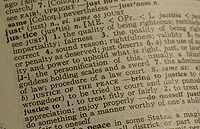Environmental Justice Definition

The U.S. Environmental Protection Agency (EPA) defines environmental justice as “the fair treatment and meaningful involvement of all people regardless of race, color, national origin, or income with respect to the development, implementation, and enforcement of environmental laws, regulations, and policies.”
The environment is everything around you. It includes your home and the place where you work. The lake where you might swim or fish, the places where your food is grown or prepared, and even the places your drinking water travels through on its way to your home. The opportunity to live a healthy life often depends on living in a healthy environment. Everyone’s environment should be free of unhealthy materials or hazards that can cause illness or even death.
Environmental justice has two major parts:
Fair treatment: no group of people should have to deal with an unequal share of the harmful environmental effects that happen because of policies or operations run by businesses or government.
Policies of, or operations run by, businesses or government can at times affect the environment and can make people sick. This often means that because of where one group of people lives or works, that group suffers an unequal portion of harmful environmental effects than other groups who live in other locations. Fair treatment means that everyone has equal protection from harmful environmental effects, and a fair chance to find a house, a job, and a school in a safe and healthy environment.
Meaningful involvement: “potentially affected community residents have an appropriate opportunity to participate in decisions about a proposed activity that will affect their environment or health, or both; the public's contribution can influence the regulatory agency's decision. The concerns of all participants will be considered in the decision-making process and the decision-makers will seek out and facilitate the involvement of the populations potentially affected. 1 ”
Meaningful involvement means that affected groups of people actually take part in the decision-making process. When government starts to address the problems that make an environment unhealthy, affected citizens need to participate in the process, and that citizen involvement has to be meaningful. This is an important step in addressing the health and housing inequalities among affected community members.
Contact Us:
- Centers for Disease Control and Prevention
1600 Clifton Rd
Atlanta, GA 30333 - 800-CDC-INFO
(800-232-4636)
TTY: (888) 232-6348 - New Hours of Operation
8am-8pm ET/Monday-Friday
Closed Holidays - cdcinfo@cdc.gov


